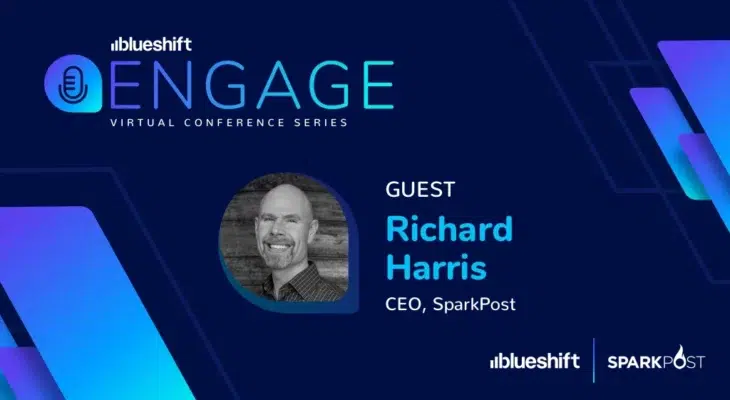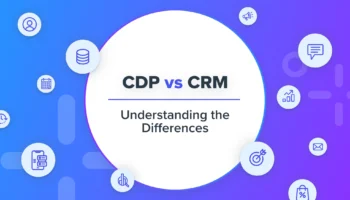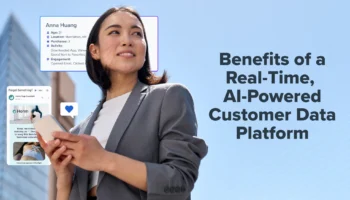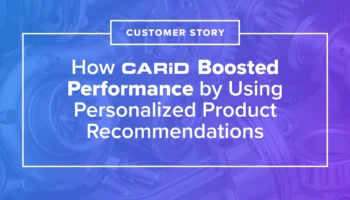Marketers, business leaders, and Blueshift users have come together for our first-ever virtual conference: Blueshift Engage. For one hour each day, we’ve brought the brightest minds in marketing to our attendees — live from their living rooms. We know marketers are busy folks, so we’ve taken our live sessions and picked out the best bits for your reading pleasure. For our final day, Blueshift’s CEO, Vijay Chittoor, sat down with Richard Harris, CEO of SparkPost to discuss how email & data-driven marketing are changing in the current COVID-19 landscape.
Blueshift Engage: Email Marketing During Economic Uncertainty

VIJAY: WITH COVID-19 IN MIND, CAN YOU TELL US ABOUT THE TRENDS YOU’VE SEEN OVER THE PAST FEW MONTHS?
Rich: The world’s completely changed, both on a personal and professional level. To me, what’s so amazing about this whole thing is how fast this change occurred. It was a matter of just a couple of weeks that everything shifted, we saw the stock market decline by 20% to 30%, which really was predicting this massive GDP decline. Q2 is probably the largest quarter over quarter GDP decline that we’ve seen in modern history and certainly since the Great Depression.
When you look at email, it has been extremely resilient and steady. If you were to overlay email sending on top of a graph of the stock market, you would see that email is countercyclical — email traffic bumped up about 5% during the stock market downdraft. Since that time, email has come down slightly, maybe about 5% in overall volume. But, for the most part, we have not seen the same sort of volatility in email traffic that we’ve seen in the economy or the stock market. Now, if we look at some of the drivers behind that, it’s really a tale of two worlds.
Some sectors are hard hit, like travel and hospitality. We’ve seen about a 54% decrease in email traffic for travel and hospitality. Events and shows are down 64% from the mean prior to COVID-19.
On the other hand, we’ve seen sectors like government and state municipalities increase traffic by about 37%. News and charity communications are also way up. But then there’s some that I find to be a little bit more interesting. For example, religion and spiritual related emails are up about 20%. Online retail is down about 15%, which may seem counterintuitive given that people are staying home, but we have to account for people saving their money. Multi-channel retail, with a brick and mortar presence, is way down as well. Overall, email has been very resilient and very stable throughout this whole crisis.
VIJAY: WHAT HAVE WINNING BRANDS DONE DURING PAST CRISES THAT WORKED WELL FOR THEM AND HOW CAN MARKETERS APPLY THOSE LEARNINGS TO OUR CURRENT SITUATION?
Rich: When I think about the span of my career, I feel like I’ve gone through 5 events that were “once in a lifetime”. So maybe volatility has just increased permanently and we’re going to have to get used to dealing with some of these shocks going forward. But to specifically hit your question on the 2008/2009 financial crisis, I think there were some really interesting lessons learned. I do believe that that crisis was very different from the crisis that we have today. This is very much an event-driven crisis, whereas that was a systemic, economic crisis.
Number one, have empathy for your customer. Focus on what you can do today to help them. If you’re still marketing the same way that you did pre- COVID-19, you’re doing something really wrong. You also need to react quickly. A great example is what Starbucks did during the 2008/2009 financial crisis.
It was very controversial, stockholders were in an uproar — the CEO of Starbucks actually shut down every single store across the country. They brought all of the employees to a central location and spent two or three days completely focused on retraining the entire workforce to focus on customer service and how to better connect with the customer.
They created all sorts of surveys and portals to collect customer feedback that was used as input to redesign their stores to make them more friendly. Starbucks became a gathering place for people who wanted to talk about what’s going on with the economy, discuss opportunities to start a new company, or hold a job interview. I remember one of the quotes from the CEO of Starbucks was, he didn’t like the smell of the store with the food that they were cooking — so they had actually changed their entire menu to make sure that it had a welcoming smell. Those changes really improved Starbucks as a brand and solidified its position for the next 20 years in terms of their growth.
Another example is Fidelity, they did an amazing job pivoting their marketing very rapidly to focus on helping people who were anxious about their investments. I remember very vividly the month of March 2009: the market was down 25% to 30%. Fidelity had a whole campaign that was designed to calm their users, not trying to encourage them to buy anything, not encouraging them to make any changes, but rather give them information and educate them so that they could remain calm during this crisis.
VIJAY: SPARKPOST EMAIL ANALYTICS POWERS ABOUT 90% OF THE WORLD’S EMAIL FOOTPRINT. WHAT KIND OF ANALYTICS ARE YOU PROVIDING AND HOW ARE YOUR CUSTOMERS LEVERAGING THAT FOR SUCCESS?
Rich: What we’re seeing in the email environment is a huge shift — and this was very much led by Google, but now you’re seeing Verizon Media Group and Microsoft also be involved. Google has always used artificial intelligence to determine email placement, but they’ve started to use more advanced types of AI and look at many, many more data signals. They’re not just looking at the domain of the email sender to determine whether or not it should be placed in the inbox, but much more.
They’re looking at website traffic, who’s searching for the website, and content on your website to determine what they want to do with that email. They’re constantly updating this information on a daily or weekly basis. If you want to be successful in this new AI-driven environment, you have to be powered by very sophisticated analytics in order to get the most out of your email sending. And so, SparkPost has decided to go deep into deliverability analytics.
These analytics are not just about open or bounce rates. We do give you that basic information, but what’s more important is who is engaging with that email and how they engage with it.
For example, you email everyone on your list and get a spam block — you go into reaction mode. At SparkPost, we want to get ahead of that and use data to extract insights from how other people are sending, how you’re sending, and determine if you’re at risk of a block before it happens. Then we can make changes to your email sending practice and always keep your deliverability at a very high level.
That was one of the reasons why we purchased eDataSource, which is a deliverability analytics company now integrated into our platform. We’re trying to create a closed-loop between analytics and sending. We see this as a part of a sending infrastructure layer, which underpins the marketing technology companies, like Blueshift, who are incredibly good at determining which channel, what message, and what customer to send to.
VIJAY: WHAT DO WINNING BRANDS DO DIFFERENTLY FROM AVERAGE BRANDS?
Rich: If you look at top brands, there’s this really interesting intersection between creativity, or art, and science. The brands that can blend those two things together are by far the most successful. That, to me, is really the recipe for success. If you need someone that can really understand what’s going on with a particular campaign, gather the data, get insights, and be honest with themselves about what’s working and what’s not — but at the same time be able to construct creative that truly connects with customers on an emotional level.
Marketers need to understand what do people actually want, what do they care about, what’s going to help improve their lives, and really what matters to them. That’s a very emotional and qualitative question, but which campaigns work and why is a very quantitative question. Melding those two together is the recipe for success.
VIJAY: WE’VE POLLED OUR ATTENDEES AND OVERWHELMINGLY, CUSTOMER DATA AND SEGMENTATION SEEM TO BE THE BIGGEST PAIN POINT FOR MARKETERS. WHAT ARE YOU SEEING IN THE MARKET AROUND THIS?
Rich: I think customer data and segmentation has been a huge issue for a long time. If I go back to my AddThis days when we were collecting massive amounts of third party data, segmenting it, and using that data to help brands to target customers in a personalized way — getting good data on your customers and making sure that data has integrity was a huge challenge. It still is today.
Unfortunately, at least from my perspective, I’m not sure it’s getting easier. Look at what’s going on with third party cookies — Apple and Firefox have deprecated their support of third party cookies. Now Chrome has announced that they’re going to as well.
That’s gonna make customer acquisition costs probably go up. It’s going to be more expensive without the ability to leverage third-party data. It will become that much more important to focus on understanding and retaining your existing customers. Email is a great way to do that — particularly in North America and in Europe where people prefer to receive brand communications via email.
It’s more important than ever for brands to really invest in first-party data assets and building those data assets out and owning them. If you’re using Facebook or Google, you don’t really own the data that you’re using to target. So you’ve gotta be careful and that’s another element to think about as you’re deciding which channels to target your customers on.
VIJAY: HOW ARE YOUR CUSTOMERS TAKING STEPS TO INTEGRATE EMAIL INTO THEIR BROADER MULTI-CHANNEL ENGAGEMENT STRATEGIES?
Rich: You have to put yourself in the shoes of the customer and meet them where they want to be. Don’t send them an SMS if they don’t want a text. You have to get feedback from your customers. If you find that customers do want to get their marketing via SMS, then great.
But there may be an evolution. So someone who’s a new customer may be more tentative, they only want to receive communications from you in email and would find SMS intrusive. A loyal customer that has been with you for a long time, wants to know about that flash sale, and they want it on SMS because they only check their email once an hour. It all comes back to putting yourself in the shoes of the customer.
VIJAY: HOW DO YOU ADVISE EMAIL MARKETERS AND DATA-DRIVEN MARKETERS TO ADAPT TO OUR CHANGING WORLD? WHAT KIND OF SKILLS AND CAPABILITIES SHOULD THEY FOCUS ON TO FURTHER THEIR CAREER?
Rich: In terms of your career, you need that really interesting mix between art and science. You need the capability to be creative, be empathetic, and understand the emotional component, but at the same time understand the data. This was the reality before COVID-19 too. Going forward it’s going to become table stakes to understand data. If you’re a marketer and you’re not data-driven, I think you’ve got a problem.
Brands that are doing this well are few and far between, unfortunately. Which makes it very easy to become tone-deaf very quickly. For example, I’ll give you a mistake that we made. Our email signature was advertising our annual, in-person conference. And then COVID-19 hit. We eventually changed it, but it took us probably two or three weeks before we changed it. It was pretty tone-deaf to have that signature out there.
So I think the brands that are going to be most successful are the ones that can instantaneously react to major changes and what’s going on in their customers’ lives.
VIJAY: YESTERDAY’S SPEAKERS FELT THAT YOUNG PEOPLE PREFER NOT TO BE CONTACTED VIA EMAIL, WHAT ARE YOUR THOUGHTS ON THAT STATEMENT?
Rich: I’ve actually been somewhat surprised, I haven’t found any good data on this yet — if you do, reach out! So, the answer I’m going to give is not particularly data-driven, but more qualitative. From what I can tell, people still want to receive via email versus through SMS because they can check it at their convenience. Whereas SMS can be a little bit intrusive.
Now, if you look at a much younger audience, like teenagers or early 20-somethings, SMS and other chat apps like WhatsApp are clearly the way they prefer to communicate. But, I think it’s still unclear whether or not they’ll want to have that channel also be the primary channel for receiving marketing offers.
VIJAY: WHAT ARE SOME MUST-HAVE ANALYTICS REPORTS? HOW MUCH CAN YOU TRUST THESE KINDS OF ANALYTICS?
Rich: Any analytics platform is only as good as the data that inputs into it. One of the reasons we purchased eDataSource is because they use a disparate set of data — and then we also had our own data. So now we have something like 8 to 10 different data sources that are feeding into our analytics platform. That allows us to triangulate on accurate insights and accurate statistics. The more data sources that you have, the better.
We use actual panel data from people that have given us permission to observe their inbox. That’s very valuable data, but that’s only as good as the panel coverage. So, we supplement that panel coverage with many different types of data, whether it’s intelligent seeding, a standard seed, etc. And we’re able to get actually quite accurate estimates of email volume and what type of deliverability folks are getting. The reason we know it’s accurate as we can backtest it on our own.
I think it’s really important to be able to do that because then you can also see, for example, geographically, do you have good data integrity or if you are lacking.
You can then focus your data acquisition efforts to cover those geographic areas. We see the same thing in email, where there are certain countries where maybe we don’t have as much data as we would like to have. So, we have to look at supplementing it in different ways.
VIJAY: HOW DO YOU CHALLENGE YOUR PRODUCT OR ENGINEERING TEAMS TO MAKE SURE THAT DATA-DRIVEN INSIGHTS ARE RELEVANT TO MARKETERS?
Step back and think about data that you actually have, rather than the data you can get. Probably the number one thing that surprised me over the last decade, is the move towards a high concern around privacy. I think people have always been concerned about privacy, but I don’t think people predicted and realized how serious people were about privacy and how quickly things were going to change.
Honoring all those different privacy regulations and regimes is critical so that when you actually use the data you have, it won’t feel creepy or strange, right? Before a lot of those privacy regulations went into place, we saw some really strange things happen, where you may have gotten an advertisement that was inappropriate. That invasive behavior is how you destroy the consumer-brand relationship completely.
FINAL THOUGHTS
This session was jam-packed with valuable insights into the world of email. Firstly, how SparkPost is an API of sorts that enables tons of possibilities, far beyond transactional email. And then dug deeper into COVID-19 and we started discussing how email marketing is not dead and its dip during the crisis has remained relatively minor — it still has the highest ROI of any marketing channel.
Next we addressed leading with empathy, the example Rich gave from Starbucks was fascinating. We also discussed data and AI in-depth, and leveraging that data with trust to power AI and to ensure AI has enough backtesting to keep learning and continuously evolving. Great insights from Rich and we hope today’s session will empower marketers to use data to their advantage and further their careers with the power of analytics.


